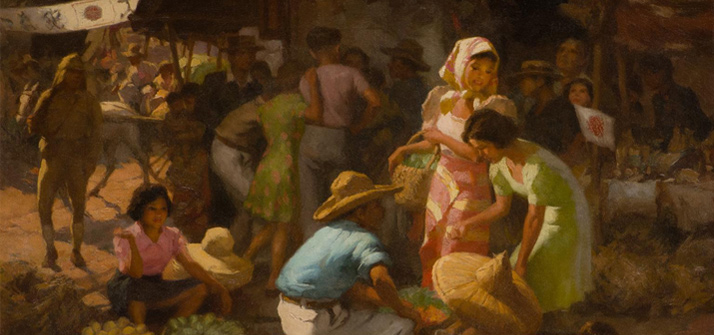
Detail of Fernando Cueto Amorsolo,
Marketplace during the Occupation (1942). Collection of National Gallery Singapore © Fernando C. Amorsolo Art Foundation Philippines. Image courtesy of
National Heritage Board.

Cultures of Occupation in Twentieth Century Asia (COTCA)
About the project
How has foreign occupation shaped culture? What has been the lasting cultural legacy of foreign occupation in those societies where it represented a common state of affairs for much of the modern era? These are key questions which, in light of ongoing cases of occupation around the world, remain crucial in the 21st century.
Cultures of Occupation in Twentieth Century Asia (COTCA) will address these questions by analysing how occupation - be it under colonial, wartime or Cold War powers – gave rise to unique visual, auditory and spatial regimes in East and Southeast Asia.
Objectives
The core objective of this project is to produce a paradigm shift in the study of occupation, and to challenge the 'collaboration'/'resistance' dichotomy which has defined the field thus far. It will adopt a transnational, intertextual and comparative approach to the study of cultural expression produced under occupation.
The three streams
The COTCA Project will be run along three interconnected streams:
- Representations of occupation
- Sounds of occupation
- Spaces of occupation
These streams shall start in year one, two and three of the project respectively.
The major objectives of Stream 1 (Representations of Occupation) are to:
- provide a comprehensive understanding of the ways in which occupation was represented by those who experienced it in twentieth-century Asia
- trace how the experience of occupation led to the development of specific visual cultures in East and/or Southeast Asia. In other words, what did occupation look like?
The major objectives of Stream 2 (Sounds of Occupation) are to:
- understand how individuals or groups who operated under occupation developed new forms of auditory expression which justified their responses to occupation
- explain how the experience of foreign occupation led to specific auditory cultures and soundscapes which were unique to such a context. In other words, what did occupation sound like?
The major objectives of Stream 3 (Spaces of Occupation) are to:
- determine how occupation gave rise to new forms of cultural expression in the spatial realm (eg. manipulation of the natural and built environment for cultural purposes; the re-ordering of existing spaces or architectural forms in the occupation context, etc.)
- trace how cultural representations, and interpretations of space and landscape, were altered by occupation. In other words, what was the shape of occupation?